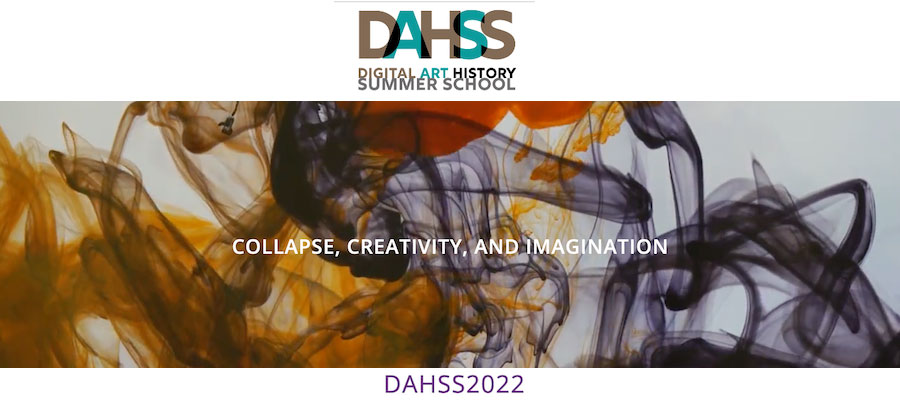VII Digital Art History Summer School: Collapse, Creativity, and Imagination, Málaga, August 29–September 3, 2022
The International Summer School on Digital Art History (DAHSS), a joint initiative of the University of Málaga and the University of Berkeley, with the collaboration of the Ludwig Maximilian University of Munich, the Western Ontario University, the University of Cambridge, the Fundación General de la Universidad de Málaga, and the HDH, will celebrate the seventh edition from August 29th to September 3rd (2022) in person in Málaga.
2022 Theme: Collapse, Creativity, and Imagination
The ideas of progress, growth and expansion, which for a long time defined the visions about the future in Western cultures, and marked the action strategies (social, economic and political) undertaken have been replaced in the last few years by the idea of "collapse". Recent events (pandemic, invasion of Ukraine, etc.) and systemic facts (global warming, resource depletion, etc.) lead us to believe that the world, as we have known it up to now, is heading towards a total collapse. Different authors have defended in recent years the need to articulate a debate on collapse that helps us to think about how such collapse could be triggered and what its implications would be (Servigne and Stevens, 2015). Within the framework of DAHSS22, we propose to think about creativity as a mechanism to ameliorate the causes that lead us to a collapse and to imagine possible alternative futures. Thus, the DAHSS22 five tracks will revolve around the following central question: How can creativity and imagination, in alliance with contemporary digital, technological and computational developments, become an asset to replace the idea of collapse with that of rebirth for thinking and making a new future?
The DAHSS schedule is divided into three different types of sessions: plenary sessions, coffee talks and track sessions. The course is organized around five tracks. Each participant can only join one of the tracks. During your application, you should select the tracks in your preferred order.
Track A: Digital Display Spaces
Greg Niemeyer will work with participants in configuring digital spaces for exhibitions on virtual platforms such as newart.city and modzilla hub. Techniques include basic modeling and animation, .fbx or .glb file format, spatial strategies for virtual engagement, data visualization and local sound synchronization in virtual spaces. Track A participants will create content and curate content produced in the other Tracks to cumulate in an online virtual exhibit about DAHSS 2021.
Track B: Data Science
Cultural data—well used, managed, and analysed—is of immense value for the understanding of art history and its impact on society. Open data is an opportunity to engage the public with cultural heritage, foster diversity and create knowledge. In this track, led by Harald Klinke (LMU Munich), we will investigate open data sources, learn the fundamentals of cultural data analysis, and use simple but powerful computational tools. No prior experience is necessary. Bring your own data.
Track C: 3D Data, Modeling, and Rendering
This track will explore 3D data acquisition techniques, such as photogrammetry and laser scanning, and their use in VR and related virtual environments. We will experiment with different ways of exploring virtual space, and will see how we might use augmented and virtual reality to practice Digital Art History. We will also ask ourselves how to best design visualizations and historical reconstructions for these environments.
Track D: Computer Vision, Machine Learning, AI
Track D, led by Leonardo Impett (University of Cambridge), will think about applications of AI and computer vision to the history of art and visual studies. Thinking about ‘the visual’ is a major difference between digital art history and ‘digital humanities on art history’. We will look at the long history of the computer analysis of images from the late 1980s to today, as well as thinking about the implicit theories of vision that underpin computer vision systems today. We’ll learn to use some basic image processing tools and more sophisticated AI and machine learning algorithms to search within, organise, or study large image sets. Using tools like Scikit-Image, Tensorflow, and ImageGraph (a visual AI tool which we wrote specifically for DAHSS), we will build systems that deal with genuinely big image datasets. For the first time, we will also look at AI systems that generate images like DALL·E, and ask how we might use them as art historians.
Track E: Natural Language Processing (NLP)
Led by Yadira Lizama Mué (CulturePlex Lab, Western Ontario University) will explore the applications of NLP to understand what textual big data can tell us about art. By combining the power of linguistics and computer science, NLP considers the guidelines and structure of language and creates intelligent systems that comprehend, break down, and separate meaning from text and speech. We will explore a wide range of NLP topics relevant to the context of Digital Art History, starting with the basics like word tokenization & tagging, semantic similarity, named-entity recognition, topic modelling, and leading to deep learning applications to sentiment analysis, text classification, and human-like text generation. We will gain practical experience using tools such as Spacy, and TensorFlow while exploring collections of art-related texts in the H.W. Wilson's Art Full Text database, Project Muse, Wikipedia, and social media platforms. You are welcome to bring your own data and ask questions about the applications of NLP to your own research.
Intended audience: postgraduate students, academic researchers, independent scholars and professionals related to the following disciplines: Art History and Visual Studies, Fine Arts, Graphic Design, Computer Sciences, Media and New Media Studies, Museum Studies, and Humanities.
Applications due June 6, 2022. Fee: 200€
